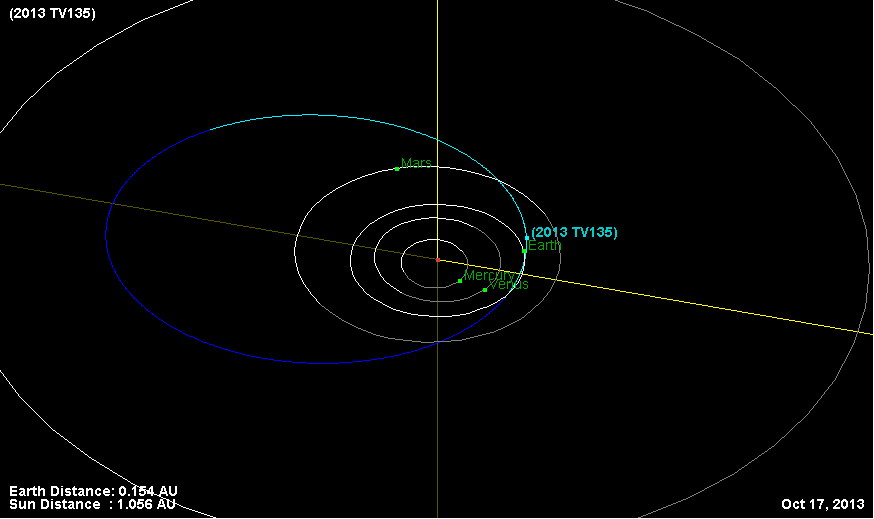Large Asteroid to Buzz Earth in 2032, But Poses Little Threat, NASA Says

A recently discovered 1,300-foot-wide (400 meters) asteroid that passed near Earth last month could pay the planet another close visit in 2032. But, NASA officials say there is nothing to fear, as the odds that the space rock will hit Earth are extremely slim.
The asteroid (named 2013 TV135) was discovered on Oct. 8, by astronomers at the Crimean Astrophysical Observatory in Ukraine. Several weeks before it was spotted, however, the huge space rock flew within 4.2 million miles (6.7 million kilometers) of Earth on Sept. 16.
Many details of the asteroid's orbital path are still unknown, but astronomers estimate it could be back in Earth's neighborhood in less than 20 years. Still, NASA's Near-Earth Object Program Office, which monitors potential threats to the planet, says the probability that 2013 TV135 will impact Earth is only one in 63,000. [Video: Asteroid 2013 TV135's Near-Earth Flyby]
"To put it another way, that puts the current probability of no impact in 2032 at about 99.998 percent," Don Yeomans, manager of the Near-Earth Object Program Office at the Jet Propulsion Laboratory in Pasadena, Calif., said in a statement.
In the coming months, astronomers will continue to study 2013 TV135 in order to improve calculations of the space rock's orbit. Once more is understood about the asteroid, NASA scientists expect the risk of impact with Earth will be dramatically reduced, or even eliminated.
"This is a relatively new discovery," Yeomans said. "With more observations, I fully expect we will be able to significantly reduce, or rule out entirely, any impact probability for the foreseeable future."
Initial observations of 2013 TV135 indicate that it follows an orbit that takes it as close to the sun as Earth, before swinging out three-quarters of the distance to Jupiter's orbit.
Get the Space.com Newsletter
Breaking space news, the latest updates on rocket launches, skywatching events and more!
Astronomers who have been monitoring 2013 TV135 say it takes almost four years for the space rock to complete one full orbit.
NASA's Near-Earth Object Program Office is tasked with finding, tracking and characterizing asteroids and comets that may pose a threat to the planet. Yeoman and his colleagues use telescopes on the ground and in space to plot the orbital positions of these objects over time. Since Oct. 14, a whopping total of 10,332 near-Earth objects have been newly discovered.
Follow Denise Chow on Twitter @denisechow. Follow us @Spacedotcom, Facebook or Google+. Originally published on SPACE.com
Join our Space Forums to keep talking space on the latest missions, night sky and more! And if you have a news tip, correction or comment, let us know at: community@space.com.

Denise Chow is a former Space.com staff writer who then worked as assistant managing editor at Live Science before moving to NBC News as a science reporter, where she focuses on general science and climate change. She spent two years with Space.com, writing about rocket launches and covering NASA's final three space shuttle missions, before joining the Live Science team in 2013. A Canadian transplant, Denise has a bachelor's degree from the University of Toronto, and a master's degree in journalism from New York University. At NBC News, Denise covers general science and climate change.
Most Popular
